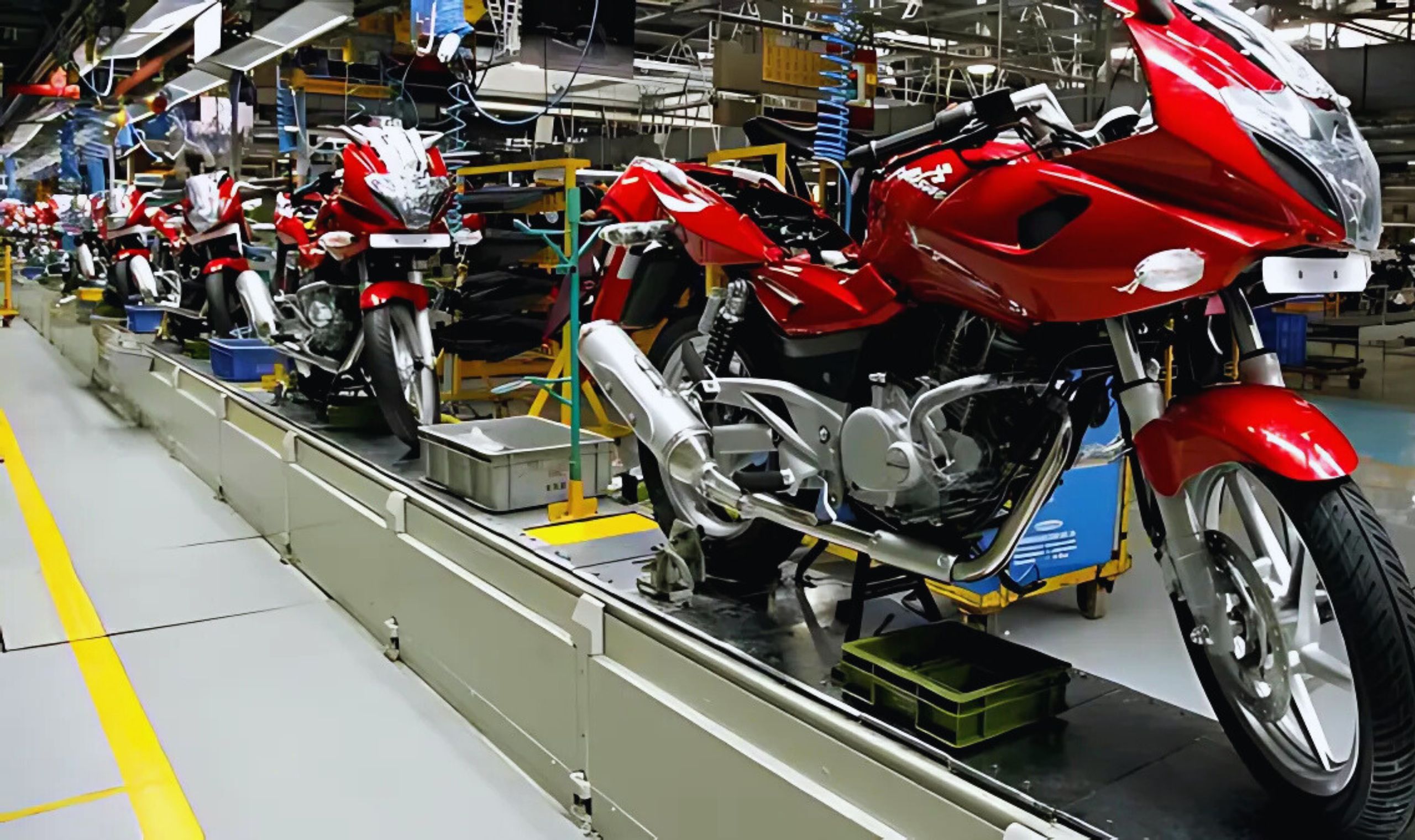The two-wheeler industry in India has always been highly competitive, with companies constantly vying for market share through innovations and pricing strategies. Bajaj Auto, one of the leading players in the Indian motorcycle market, has recently made headlines with its decision to slash the prices of its Freedom 125, a product launched only five months ago. The price cuts, which saw a reduction of Rs 5,000 for the entry-level variant and Rs 10,000 for the mid-level variant of the Freedom 125, have raised concerns among investors and analysts alike, leading to a decline in Bajaj Auto’s stock price. In this blog, we’ll dive deep into the implications of this decision, examine the market dynamics influencing Bajaj Auto’s performance, and explore the company’s prospects.
Bajaj Auto Stock Falls on Price Cuts
Bajaj Auto stock declined by over 2% after the company announced price cuts on its Freedom 125 model. The stock erased all its weekly gains, trading at Rs 8,995.85 on the NSE at 12:21 pm on December 4, 2024, as it reversed early gains. After just five months since the roll-out of Freedom 125, this pricing slash would prove quite worrying for investors regarding the company’s sales and market performance in general.
This price reduction was viewed as an attempt to clear unsold inventory, which may indicate low demand for the Freedom 125 model. The company’s decision to cut prices was further complicated by similar price reductions on other popular models such as the Pulsar after the Diwali season, leaving investors to question the health of Bajaj Auto’s domestic sales and the company’s ability to maintain growth.
What Does the Price Cut Mean for Bajaj Auto?
Bajaj Auto unveiled its Freedom 125 as the world’s first CNG-powered motorcycle in early 2024. The Freedom 125 was seen as one of the key offerings from Bajaj Auto that would help the company corner a larger share of the eco-conscious, cost-sensitive market segment. The company aims to capture the growing demand for CNG-powered vehicles. This fast-emerging segment has gained popularity in recent years with rising fuel prices and environmental concerns.
But then again, cutting prices only five months after the launch does raise some questions. UBS Securities said that the entry-level variant of Freedom 125 had its price cut by Rs 5,000 and the mid-level variant by Rs 10,000. This may make the product more affordable for consumers, but it may also mean that the product did not reach the expected demand in the market, especially when compared to other models in the same segment.
Problems in Bajaj Auto’s Domestic Sales
One of the main reasons behind the decline in price and the corresponding fall in the Bajaj Auto stock price is its slow domestic sales. Inn November 2024, Bajaj Auto recorded a year-on-year domestic sales decline of 7% during the festive season, which usually marks a busy period for two-wheeler companies. Bajaj Auto sold 2.40 lakh units in November 2024, lower than 2.57 lakh units in the same month the previous year.
These could be some of the reasons behind the sales drop, which include:
1. Economic Slowdown:
Indian economy has faced many problems such as high inflation and an uneven recovery post-pandemic that has affected consumer spending, particularly in the automobile industry.
2. Competitive Pressure:
Bajaj Auto is competing in the market where several other players, like Hero MotoCorp, Honda, and TVS, are also coming with new models at a competitive price. Therefore, such high competition could have made the consumers prefer changing the products, which leads to less demand for the product.
3. Changing Consumer Preferences:
Traditional fuel-based two-wheelers could be losing appeal among more and more younger consumers, who are growing ever more inclined towards electric vehicles (EVs), along with a shift towards electric mobility and greater environmental awareness.
Despite these challenges, its performances in international markets were up and strong. Its exports during November 2024 rose by a significant number to 1.80 lakh units, marking 24% growth from the base of the previous year. This great increase in exports offset domestic sales that fell to report a 5 per cent increase in total sales during November.
Future Prospects for Growth in Bajaj Auto
While the price cuts on the Freedom 125 model and the overall decline in domestic sales are worrisome, Bajaj Auto is hopeful about its long-term growth prospects. “We expect to outperform the industry’s growth forecast of 6-8% in the coming years,” said Rakesh Sharma, Executive Director, Bajaj Auto.
Some of the key growth strategies that Bajaj Auto is focusing on include:
Bajaj Auto has a good market share in the 125cc and above segment. It has a market share of around 24-25%. The company feels that it can expand more in this segment and hence it is introducing innovative products like the Freedom 125, designed for the growing number of eco-conscious consumers.
a) New Product Launches:
Bajaj Auto is indeed investing in new product launches, which would keep the growth trajectory going. Its strong R&D capability and diversified portfolio in terms of products have protected it from market competition.
b) Strengthening Pulsar Lineup:
The Pulsar lineup happens to be one of the best-selling product lines for Bajaj Auto. So, new variants and updations in the lineup would continue. The company is focusing more on this lineup to remain strong in the performance bike segment among the youth.
c) CNG and Electric Mobility:
As the demand for alternate fuels and electric mobility gains pace, Bajaj Auto has made some significant headway in the CNG space with Freedom 125. In the future, it may also look at the electric two-wheeler market, as that is a very fast-evolving space in India and around the world.
The international business ventures of Bajaj Auto are still expanding its distribution chain in various regions, including those classified as emerging economies. Exports will be the major contributor to future growth since motorcycle and scooter demand is seen increasing in regions like Africa, Southeast Asia, and Latin America.
Bajaj Auto’s Share Price and Market Sentiment
Despite the recent price cut, Bajaj Auto still holds a significant position in the Indian two-wheeler market, and the valuation of its stock is consistent with this. Historically, the stock has been perceived as a good performer, but recent changes have made it a reevaluated prospect.
The recent 2% dip in its stock price on December 4 highlighted investor concerns, but one needs to note that the valuation of Bajaj Auto is still relatively stronger than many of its peers. Analysts and investors will be closely watching the company’s upcoming earnings reports, product launches, and performance in both domestic and international markets to assess whether the company can maintain its growth trajectory in the face of rising competition and evolving consumer preferences.
Conclusion
This price cut by Bajaj Auto on the Freedom 125 just five months after its launch brings forth several questions regarding the company’s domestic sales performance and the demand for conventional motorcycles. Though still facing big challenges, especially in its domestic market, it is well laid for the future with good export growth and a diversified product portfolio.
The price cuts may have reflected short-term dips in the stock prices of Bajaj Auto but the company is more equipped to benefit from future possibilities in the 125 ccs + segment, alternative fuel vehicles and also electric mobility. Investors have got to keep an eye out and watch if the management indeed executes these strategies without creating regulatory and market hassles. With a strong focus on innovation and market expansion, the outlook for Bajaj Auto, though promising, would change its profile as the Indian and international automotive industries are likely to change.
As always, market participants should continue watching Bajaj Auto for its quarterly performance, product launch, and strategy decision to determine whether the stock can recover and continue in the years ahead.















0 Comments